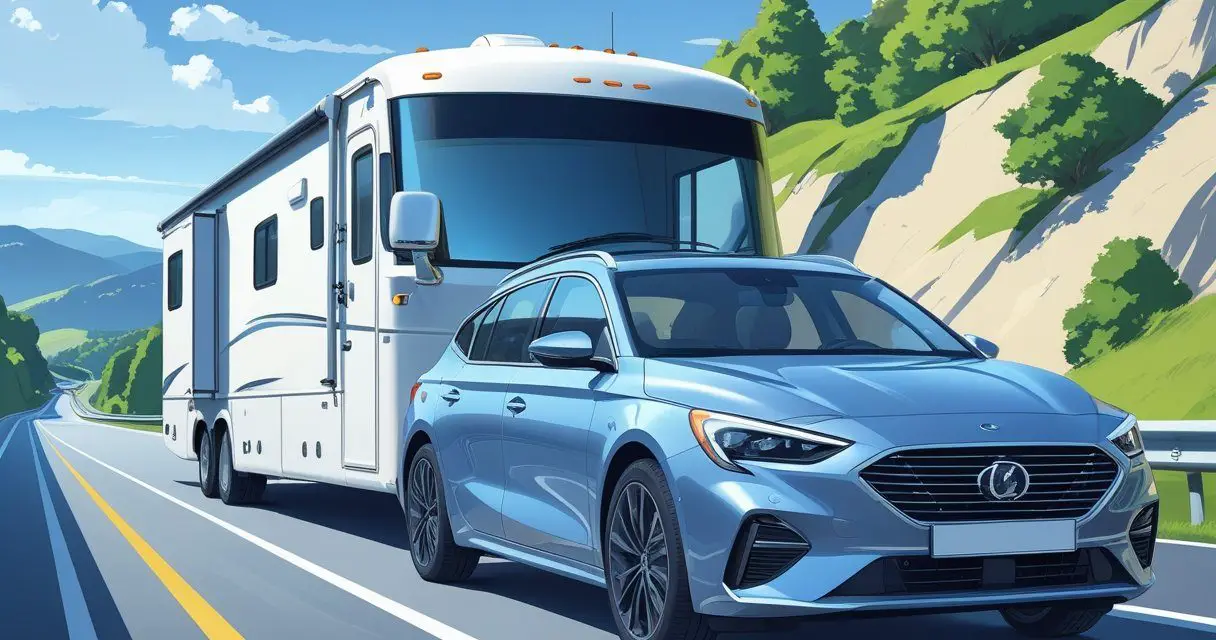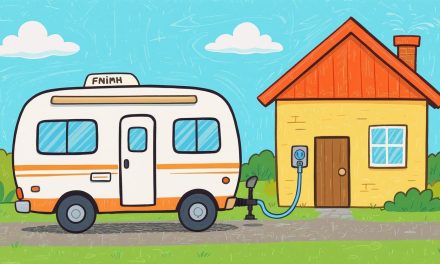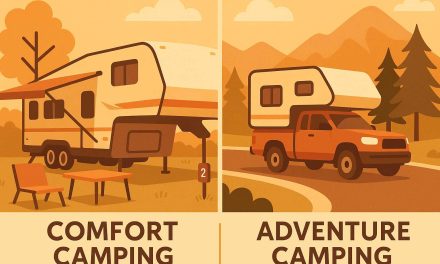Would you like to save this article?
So you’re thinking about hitting the open road with your shiny RV in tow? That’s awesome! But before you start living out your Instagram-worthy road trip fantasies, let’s talk about the not-so-glamorous reality of RV towing.
According to the National Highway Traffic Safety Administration (NHTSA), trailer-related accidents cause thousands of crashes every year, and many of them are completely preventable. The truth is, towing an RV isn’t just “driving but longer”—it’s more like hauling a second home behind you at highway speeds while hoping physics stays on your side.
This article breaks down the top 9 mistakes RVers make when towing, and trust me, these aren’t just minor oopsies. We’re talking about the kind of mistakes that turn your family vacation into a starring role in “Epic RV Disasters Gone Wild.” Whether you’re a first-timer or a weekend warrior, you’ll learn how to tow safely, avoid becoming a cautionary tale, and actually make it to your campsite with your sanity (and marriage) intact.
1. Ignoring Weight Limits Like They’re Just Suggestions
Here’s the thing about weight limits: they’re not optional. Your truck has something called a Gross Vehicle Weight Rating (GVWR), and it’s not just a random number the manufacturer threw on there for fun. It tells you the maximum weight your vehicle can safely handle.
But here’s what happens in real life. You ask an RVer what their GVWR is, and they stare at you like you just asked them to solve a calculus problem. “Uh… I think it’s, like, heavy?” Nope. That’s not how it works.
The Real Deal: According to RV Safety & Education Foundation, exceeding your vehicle’s towing capacity is one of the leading causes of RV accidents. When you overload your truck, you’re putting stress on the engine, transmission, brakes, and suspension—basically everything that keeps you alive on the highway.
| What Happens When You Overload | The Result |
|---|---|
| Truck squats low, bumper sparks | You’ve exceeded your limit, genius |
| Front tires lift off the ground | You’re basically driving a wheelie |
| Headlights aim at outer space | Houston, we have a problem |
Here’s the Kicker: If your truck looks like it’s doing squats every time you hook up the trailer, congratulations—you’re about to have a very bad day on the highway. You might think you’re saving money by towing with what you’ve got, but when your transmission gives up halfway through Montana, you’ll wish you’d just bought the right truck in the first place.
2. Treating Tongue Weight Like It’s No Big Deal
Tongue weight is the downward force your trailer puts on your hitch, and getting it wrong is like playing Russian roulette with your entire rig. The sweet spot? 10-15% of your total trailer weight should rest on the hitch.
Too light, and your trailer starts swaying across three lanes like it’s trying to flag down an Uber. Too heavy, and your front tires lift off the ground, making steering about as effective as using an Xbox controller that’s not even plugged in.
The Stats: The RV Industry Association recommends that proper tongue weight distribution is critical for safe towing. Improper weight distribution causes trailer sway, one of the most dangerous situations you can encounter on the highway.
The Laugh-Cry Moment: You’ll know you’ve got the tongue weight wrong when your headlights are pointed at the International Space Station and oncoming drivers are flashing their high beams at you in fury. At that point, you’re not towing an RV—you’re piloting a very confused aircraft that forgot how to fly.
3. Packing Your RV Like It’s a Storage Unit on Wheels
Let’s talk about how people pack their RVs. Firewood in the back, coolers stacked to the ceiling, generators hanging off the bumper, patio furniture wedged in wherever it fits. Basically, you’re treating your RV like a game of Tetris designed by someone who’s never played Tetris.
The Right Way: Heavy items go low and centered over the axles. This isn’t about how many cases of beer you can hide behind your fishing poles—it’s about physics and not dying.
According to Camping World, improper weight distribution is responsible for up to 60% of trailer sway incidents. When all your heavy stuff is in the back, your trailer starts dancing around like it just had four margaritas at Applebee’s.
The Reality Check: You might think you’re being clever by maximizing space, but when your trailer starts fishtailing at 65 mph, you’ll realize that maybe you didn’t need to bring that third generator and your entire workshop. Less is more, especially when “more” means keeping your rig on the actual road.
4. Using a Cheap, “Universal” Hitch from Walmart
You just financed a $70,000 trailer. You’ve got leather seats, a full kitchen, maybe even a fireplace. But the hitch? Oh, that came from the bargain bin at Walmart, marked “universal” like it’s some kind of miracle device that works with everything.
Here’s the Truth: Your hitch is literally the only thing connecting your expensive rolling mansion to your truck. This is not the place to bargain hunt. The National Highway Traffic Safety Administration (NHTSA) reports that equipment failure, including hitch failure, contributes to thousands of towing accidents annually.
| Hitch Quality | What You Get |
|---|---|
| $50 “Universal” Special | A prayer and good luck |
| Proper Weight-Rated Hitch | Your trailer stays attached |
| Weight Distribution Hitch | Smooth, controlled towing |
The Punchline: You know what else is universal? Gravity. And it’s the only other thing keeping your house on wheels together while you’re cruising at highway speeds. Invest in a proper, weight-rated hitch from a reputable brand. Your insurance company (and fellow drivers) will thank you.
5. Treating Safety Chains Like Fashion Accessories
Safety chains aren’t there to make your truck look pretty. They’re literally your last line of defense if your hitch fails. But people treat them like jewelry. “Oh, I just looped them around once. It looks cute!”
No. Just… no.
The Correct Way: You cross your safety chains in an X-pattern under the hitch. This creates a cradle that catches the tongue if it disconnects, preventing your trailer from dropping onto the road and becoming a 6,000-pound battering ram.
The RV Safety & Education Foundation emphasizes that properly crossed and secured safety chains have prevented countless catastrophic accidents. These chains need to be strong enough to hold your entire trailer weight, and they need to be hooked correctly.
The Brutal Truth: If you think safety chains are optional or decorative, you’re basically volunteering to star in a highway disaster compilation video. And trust me, those videos get millions of views—but you don’t want to be the star. Cross them. Every. Single. Time.
6. Not Knowing What a Brake Controller Is
Here’s a fun conversation that happens way too often:
“Hey, do you have a brake controller?”
“A what now?”
Some RV owners genuinely don’t know that brake controllers exist. They just assume their truck’s brakes will handle everything. Sure, your truck stops fine—by itself. But add 8,000 pounds of trailer behind it, and suddenly you’re creating a brand-new drive-through lane at Chick-fil-A.
The Facts: According to the Department of Transportation, brake failure or inadequate braking contributes to approximately 22% of all towing accidents. A brake controller synchronizes your trailer’s brakes with your truck’s brakes, giving you actual stopping power.
The Setup:
- Proportional controllers = Smooth braking that matches your truck
- Time-delayed controllers = Budget option, but less smooth
- No controller = A recipe for disaster and insurance claims
The Wake-Up Call: Without a properly adjusted brake controller, you’re not towing—you’re hoping. Hoping you won’t need to stop suddenly. Hoping that minivan doesn’t cut you off. Hoping your brakes don’t overheat and fail completely. That’s a lot of hope for something that costs $150 to fix.
7. Completely Forgetting Your RV Tires Exist
Nobody checks their RV tires. I mean nobody. People just assume the tires that came with the rig 11 years ago are still good to go. But here’s the thing about RV tires: they don’t wear down gradually—they explode.
And it’s never at a convenient time. Usually, it happens in the left lane at 70 mph, and suddenly your romantic camping getaway turns into a roadside tire-changing nightmare while your spouse stands six feet away with crossed arms saying, “I TOLD you to check them!”
The Numbers: The RV Industry Association states that RV tire blowouts are among the most common roadside emergencies, and tire age (not just tread depth) is a critical factor. Most RV tires should be replaced every 5-7 years, regardless of how they look.
| Tire Age | Risk Level | What To Do |
|---|---|---|
| 0-3 years | Low | Regular pressure checks |
| 4-6 years | Moderate | Inspect for cracks/damage |
| 7+ years | HIGH | Replace immediately |
The Marriage Test: At that moment on the highway shoulder, while you’re wrestling with a shredded tire and your spouse is giving you the look, you’ll be wondering: “Is this a marriage or an audition for divorce court?” Save yourself. Check your tires. Replace them when they’re old. Your relationship depends on it.
8. Driving Like You’re Qualifying for Daytona
Listen, you’re towing a house. You’re not in a race. But somehow, people get on the highway and start weaving through traffic like they’re trying to set a lap record.
News flash: Towing isn’t a sport. Think of it more like a parade where you’re moving slow and everybody hates you. Embrace it.
The Federal Motor Carrier Safety Administration (FMCSA) reports that speed is a factor in approximately 30% of all towing accidents. When you’re towing, your stopping distance increases, your maneuverability decreases, and your margin for error basically disappears.
Recommended Towing Speeds:
- Highway: 55-65 mph (even if the limit is 70)
- Mountain roads: Even slower, use lower gears
- Bad weather: Whatever speed makes you feel safe minus 10 mph
The Reality: You might think you’re saving time by going faster, but when you factor in the potential accident, the insurance claim, the totaled RV, and the PTSD from watching your vacation home cartwheel across the interstate, you’ll realize that getting there 20 minutes later was worth it. Slow down, enjoy the drive, and let those aggressive drivers pass you.
9. Skipping Pre-Trip Inspections (Or Doing Them Wrong)
For most people, a “pre-trip inspection” consists of slamming the RV door and saying, “Ah, looks fine.” Then they’re shocked—shocked—when three hours later their tail lights don’t work, the propane’s still open, and one of the safety chains is dragging down the highway throwing sparks like a Fourth of July celebration.
The Proper Pre-Trip Checklist:
✅ Check all lights (brake, turn signals, running lights)
✅ Inspect tire pressure and condition
✅ Verify all hitch connections are secure
✅ Confirm safety chains are crossed
✅ Test brake controller
✅ Close propane valves
✅ Secure all storage compartments
✅ Check weight distribution
✅ Verify towing mirrors are adjusted
According to the National RV Dealers Association, a thorough pre-trip inspection can prevent up to 80% of common towing problems. That’s not a small number—that’s the difference between a smooth trip and a nightmare.
The Hard Truth: You’re about to drive a 40-foot, multi-ton vehicle down the highway at speeds that would terrify your great-grandparents. The least you can do is spend 15 minutes making sure everything actually works. Your future self (and everyone else on the road) will be grateful you took the time.
BONUS: Other Critical Mistakes to Avoid
Driving While Exhausted
Nothing says “family vacation” like treating the trip like an endurance test. Don’t try to push through another four hours while steering an 8,000-pound death trap with the reflexes of a sloth. The National Highway Traffic Safety Administration reports that drowsy driving causes approximately 100,000 crashes annually.
Pull over. Rest. Your campsite will still be there when you arrive alive.
Wrong Vehicle for the Job
Your V6 minivan might be great for groceries, but it’s not going to make it up the Rockies towing a 7,000-pound travel trailer. Don’t ask your vehicle to do something it wasn’t designed for. Check your owner’s manual for actual towing capacity—and then stay below that number.
Not Knowing the Laws
Towing laws change from state to state. Speed limits, required equipment, and even which lanes you can use vary depending on where you are. Getting a ticket in Wyoming because you didn’t know their specific trailer laws is a pretty expensive way to learn geography.
The Bottom Line
Look, towing isn’t rocket science, but it’s not something you can wing either. Respect your weight limits, balance your load, use the right equipment, and actually check your stuff before you leave.
If you do it right, you’ll get to your campsite, set up your chairs, crack open a cold one by the fire, and actually enjoy the whole point of RVing. But if you do it wrong? You’ll be starring in the next viral YouTube video titled “RV Crash Compilation – How Did They Even Get a License?”
The choice is yours. Pack smart, drive smart, and always—always—check those tires.
Safe travels, and may your adventures be filled with beautiful sunsets and zero blown tires.
SOURCES
The Camping Loop – Original YouTube Video
National Highway Traffic Safety Administration (NHTSA) – Trailer Safety
RV Industry Association – Towing Safety Guidelines
RV Safety & Education Foundation – Weight Distribution and Towing
Camping World – RV Weight Distribution Guide
Federal Motor Carrier Safety Administration (FMCSA) – Vehicle Safety
National RV Dealers Association – Pre-Trip Inspection Guidelines
Department of Transportation – Brake Safety Standards





